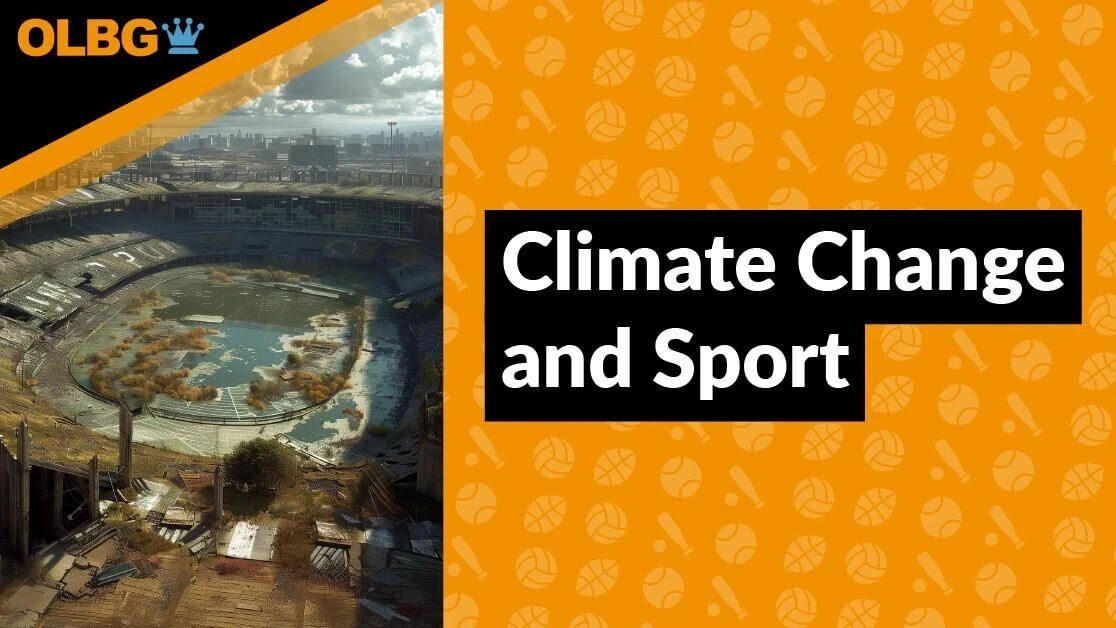
I've spent over 20 years inside the betting industry. I'll guide you to avoid the hype, ignore the noise, and steer clear of the common pitfalls that catch out everyday punters.
Climate change is expected to significantly impact sports venues, including English football stadiums, altering their structure and operations. This article explores the projected future of iconic sports stadiums and the strides made toward sustainability, according to AI.
See how AI-generated visuals depict these transformations and why adapting to climate change is crucial for the future of sports.
🏟️ A Glimpse into Future Stadiums Amid Climate Change 🌍
The Future of Sports Venues:
The effects of climate change on football and, more generally, sports venues will continue to negatively affect sporting competitions in the future. According to a report published by the Rapid Transition Alliance in 2020, almost one in four stadiums in the top four divisions of English football will experience total or partial flooding within the next quarter of a century.
Around the world, sports venues are taking the necessary steps to become more sustainable, including the 2024 Super Bowl host. Allegiant Stadium in Las Vegas was powered entirely by renewable energy sources, the first in NFL history.
But what could the most significant sports venues in the world look like in the future, given the effects of climate change? Using AI software, we would like to create artists' impressions of what some of the world's most iconic sports venues could look like due to climate change.
Old Trafford, Manchester, United Kingdom - affected by wetter winters

Old Trafford is a football stadium in Greater Manchester, England, home to Premier League team Manchester United. With a capacity of just over 74,000, it is the largest club football stadium in the UK. The image shows how the Manchester stadium could look if it were affected by wetter winters caused by climate change. The pitch has completely submerged underwater, and the severe winds have caused parts of the roof to collapse.
According to a 2020 study by The Rapid Transition Alliance, at least a third of all UK clubs have serious climate-related issues. Premier League clubs like Old Trafford are predicted to suffer as sea levels rise in line with global temperatures due to climate change. The 2023-2024 football season in the UK was hit by ten named storms, including Babet, which cancelled all but two matches in the Scottish Premier League and several more in the English Football League.
Augusta National Golf Club, Georgia, United States - affected by rising tides

Augusta National is one of the world's most exclusive and best-known golf clubs. We’ve examined how the iconic course could look in the future. In this image, rising tides have caused the course's looming water features to flood, and the grassland has eroded away, making it inoperable for players.
Erosion is already prevalent in Georgia. According to research from the Pulitzer Centre in 2021, some areas of the Georgia coast have lost salt and brackish tidal marshes. Rising water is eroding salt marshes, slowly killing patches of these wetlands. Scientists in Georgia know that salt marshes are in trouble as the warming Earth causes the sea to rise.
All England Lawn Tennis & Croquet Club, London, United Kingdom - affected by storms and hurricanes

The All England Lawn Tennis and Croquet Club is a private members' club in Wimbledon, London, England. It is best known as the venue for the Wimbledon Championships, the only Grand Slam tennis event still held on grass. The image shows how the iconic tennis court has started to become devastated by storms, with parts of it completely doused in water.
In 2023, Wimbledon celebrated Environment Day, during which leading sports figures discussed climate action. The next few years will be pivotal in bringing about the changes needed to avoid the most severe climate impacts. In tennis terms, this is breakpoint.
Cape Town Stadium, South Africa - affected by desertification and drought

The Cape Town Stadium is a football and rugby union stadium built for the 2010 FIFA World Cup. The image conveys how the major stadium could appear in the future due to the ongoing effects of drought in the region. It shows how the drought caused the top growth of the pitch to turn brown and die, as well as the damage caused to infrastructure assets due to shifts in the soil and foundations.
Droughts have been a major issue in southern Africa’s Mediterranean climate for centuries. However, the impacts of climate change intensify as more people move to the city. Between 2015 and 2018, Cape Town experienced a multi-year drought. It was one of the worst in the region’s history and took the city of around 4.6 million residents to the brink of ‘Day Zero,’ a point when it would run out of water.
St Andrews Golf Club, St Andrews, Scotland - affected by flooding

St Andrews Golf Club is a private members' golf club in St Andrews, Scotland. It has been regularly used for the Open Championship. Established in 1843, it is one of the oldest golf clubs in the world. The rise of sea levels is already having a widespread impact on parts of Scotland’s coast. In the image, we can see how the coastal floods have caused erosion to the St Andrews coastline, posing a risk to its historic buildings.
According to Golf Sustainable, the threats of flooding and storm surges are well known to St Andrews, and local partnerships have been working on projects to improve its dune structure. Recent studies assume that the sea levels in the town will rise by 90 cm by 2100, with a change of 14 mm per year. If global warming prevails, according to the Centre of Expertise for Waters study, a round on the Old Course at the end of the century will be rather unlikely.
Dodger Stadium, Los Angeles, United States - affected by storms and hurricanes

Dodger Stadium is a baseball stadium in the Elysian Park neighbourhood of Los Angeles, California and home of the 1963 World Series. In the image, AI has depicted how the stadium could be affected by hurricanes and storms. The flooding has caused the surrounding areas to overflow, and the hurricane winds have pushed the surrounding infrastructure to collapse, striking the outside walls and causing widespread damage to the interior levels and announcement boards.
According to research from the Hydrometeorological Prediction Centre, a tropical storm makes landfall about two times every three years in Los Angeles, and a hurricane makes landfall once every 2.8 years.
Lambeau Field, Wisconsin, United States - affected by flooding

Lambeau Field is an outdoor athletic stadium in Green Bay, Wisconsin, and the home field of the 4-time Superbowl champions Green Bay Packers of the National Football League. This image shows how the NFL venue could look if major floods completely submerged it. Floods can devastate sports venues by soaking the grass, damaging the soil environment for growth by replacing oxygen in the earth with water.
Flooding is the most common and costly disaster in Wisconsin, and in 2016, Lake Delton in the Wisconsin Dells breached its dam and emptied it into a nearby river. More than 40,000 homes and 5,000 businesses were damaged.
Wembley Stadium, London, United Kingdom - affected by hotter summers

Wembley Stadium is widely regarded as one of the most iconic football stadiums in the world and is considered a hub for the English game and home of the FA Cup. With 90,000 seats, it is the largest stadium in the UK and the second-largest in Europe, behind Barcelona's Camp Nou. The image shows how the stadium could be affected by hotter summers and the pitch has completely dried out from the little rainfall. When the heat outside increases, the roots beneath the soil shrink in size to reduce the amount of water to conserve energy. The seats at the stadium are also losing their colour.
With climate change, London is vulnerable to extreme heat episodes and heatwaves in the summer and warmer, wetter winters. The Met Office has reported that overheating is a year-round problem and that many of London’s existing homes were not built for climate change.
Optus Stadium, Perth, Australia - affected by invasive species and pests

Optus Stadium is a multi-purpose, world-class venue in Perth, Western Australia opened in December 2017 with the first event being a Twenty20 cricket match. It hosts the Australian Football League, cricket, football, rugby league, rugby union, and concerts. In this image, we can see how invasive species could affect Optus Stadium. The spread of pests weakens ecosystems, making sports venues more vulnerable to the effects of climate change.
Thousands of species have been introduced inadvertently to Australia, including species detrimental to the environment. Climate change is increasing the range shifts, where pest management is a significant economic burden in the country.
Rungrado 1st of May Stadium, Pyongyang, North Korea - affected by desertification and drought

The Rungrado 1st of May Stadium is a multi-purpose stadium on Rungra Island, Pyongyang, North Korea. Officially, the Rungrado May Day Stadium has a capacity of 150,000 spectators, but internet observers put the figure at 114,000. The stadium is used for football matches, athletics events, and, most often, the mass games of the Arirang Festival. The image shows how the North Korean stadium could look if it were affected by desertification. Desertification is how vegetation in drylands, grasslands or shrublands decreases and eventually disappears. The drought conditions have weakened the grass pitch, and the roots have completely deteriorated.
In 2023, the Ransong reservoir in Pyongyang experienced a significant water decline. The state’s media reported a nationwide effort to save the crops from damage. Satellite imagery between 2022 and 2023, according to the Korean Institute for Security and Strategy, showed that spring droughts had greatly reduced water levels.
Methodology
A seed list of the most prominent sports venues worldwide for various sports was taken from listicles like Rugby 365, FourFourTwo, and Football Ground Guide.
The AI imagery used for these images was Midjourney and Adobe Firefly. The prompts used were the stadium name combined with each climate change factor. E.g., “Cape Town Stadium, Desertification and drought’.
Commentary and quotes
Please feel free to use these quotes if reproducing parts of this article, and kindly link to the page or olbg.com - Thank you
“The summers are getting wetter, and in 2024 alone, we’ve seen a lot of rain disruption at major events such as Roland Garros for the French Open tennis, and the T20 Cricket World Cup, where rain washouts have spoiled play for the likes of England and hosts USA.
“While the world around us adapts, so do sports venues; rarely will you see major arenas at the top level of sport go years without rejuvenation. Nevertheless, the worry of future climate impact is stark for some areas more than others. The OLBG team has used AI programme Midjourney and Adobe Firefly to depict a worrying future for world sport.
“Factors such as rising tides, wetter winters, desertification, and drought were considered when selecting our seeding list of sports stadia. At OLBG we recently reimagined Manchester United’s Old Trafford stadium as a luxurious 100,000-seater stadium. This time around, however, our AI image is more stark as it shows how the stadium could look if it were affected by wetter winters caused by climate change. The pitch has completely submerged underwater, and the severe winds have caused parts of the roof to collapse.
“Whether climate change will impact our sporting calendar, rules, or regulations in the future remains to be seen. But one thing is for certain, and this is that these historic sports grounds above need to be cherished and protected from these events at all cost.”



